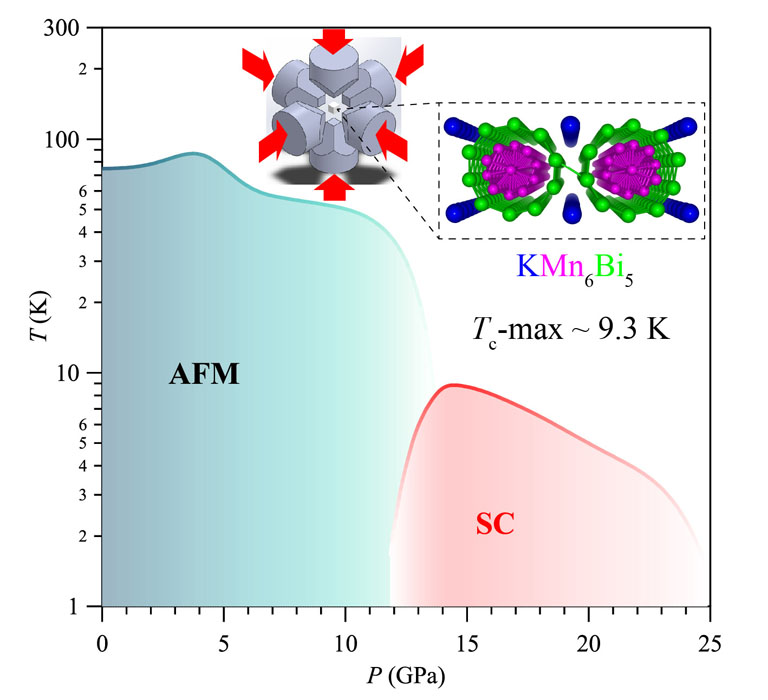Pressure-Induced Superconductivity up to 9 K in the Quasi-One-Dimensional KMn6Bi5
Uwatoko Group
Unconventional superconductivity beyond the Bardeen-Cooper-Schrieffer theory usually emerges on the border of long-range antiferromagnetic order as exemplified by the cuprate, iron-pnictide, and heavy-fermion superconductors. In these cases, the enhanced magnetic fluctuations are believed to be the binding glue of Cooper pairs. As such, it is expected to find unconventional superconductivity in the vicinity of the antiferromagnetic quantum critical point (QCP), which can be achieved by employing external tuning parameters such as chemical doping and applying physical pressure. By following this approach, we discovered the first Mn-based superconductor MnP by suppressing its helimagnetic order via the application of high pressure, even though the Mn-based superconductor is rare owing to the strong magnetic pair-breaking effect. Its superconducting transition temperature Tc ≈ 1 K is low and the superconductivity only appears in a narrow pressure range around Pc ≈ 8 GPa where the helimagnetic order just vanishes. Since then, we have been devoted to find more Mn-based superconductors with higher Tc. In this regard, we pay special attention to the ternary or complex Mn-based magnetic materials with low-dimensional structures, in which the enhanced magnetic fluctuations are expected to promote stronger superconducting pairing and thus higher Tc in comparison to the three-dimensional MnP. After seven-year endeavor, we recently discovered the first ternary Mn-based superconductor KMn6Bi5 [1].
KMn6Bi5 is a newly synthesized ternary compound with a quasi-one-dimensional (Q1D) monoclinic structure featured by the presence of infinite [Mn6Bi5]− columns along the b-axis as shown in the inset of Fig. 1. These columns are composed of an outer nanotube of Bi atoms surrounding an inner Mn–Mn bonded metallic core. At ambient pressure (AP), KMn6Bi5 undergoes an antiferromagnetic transition at TN ≈ 75 K, which is manifested as a pronounced anomaly in resistivity and magnetic susceptibility. Curie–Weiss fitting to the paramagnetic susceptibility above TN yield a relatively small effective moment of Mn, i.e., 1.4-1.6 μB, signaling an itinerant nature of the magnetism similar to MnP. First-principles calculations have revealed that the density of states at the Fermi level are dominated by the Mn-3d electrons and the helical antiferromagnetic structures are stable.
By measuring resistance and ac magnetic susceptibility under hydrostatic pressures up to 14.2 GPa in a cubic anvil cell apparatus, we find that its antiferromagnetic order is first enhanced moderately and then suppressed completely at a critical pressure of Pc ≈ 13 GPa, around which bulk superconductivity emerges and exhibits a domelike Tc(P) with the maximal Tconset ≈ 9.3 K achieved at 14.2 GPa. As shown in Fig. 1, the close proximity of superconductivity to a magnetic instability in the temperature-pressure phase diagram of KMn6Bi5 resembling many unconventional superconducting systems mentioned above suggests an unconventional magnetism-mediated paring mechanism. Its unconventional nature is also substantiated by the observations of strange-metal behavior in the normal-state resistance near Pc and an unusually large μ0Hc2(0T) exceeding the Pauli limit. Since the theoretical calculations on KMn6Bi5 suggest dominant contributions of Mn-3d orbital electrons to the density of states at Fermi level, it becomes the first ternary Mn-based superconductor with a relatively high Tc of 9.3 K, which is one order of magnitude higher than that of MnP (~1 K). In contrast to the binary MnP, the flexibility of the crystal structure and chemical compositions in the ternary AMn6Bi5 (A = alkali metal) can open a new avenue for finding more Mn-based superconductors.
References
- [1] Z. Y. Liu, Q. X. Dong, P. T. Yang, P. F. Shan, B. S. Wang, J. P. Sun, Z. L. Dun, Y. Uwatoko, G. F. Chen, X. L. Dong, Z. X. Zhao, and J.-G. Cheng, Phys. Rev. Lett. 128, 187001 (2022).

